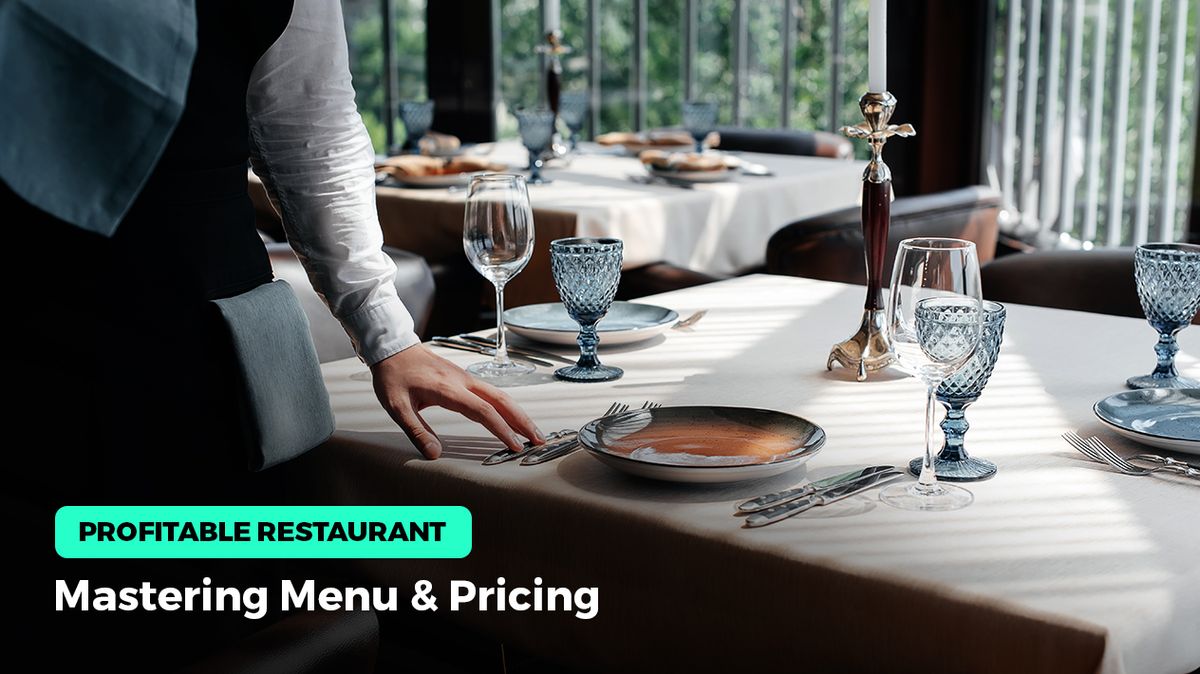Profitable Restaurant: Mastering Menu & Pricing

The influence that a menu has on clients is a fact that customers are unaware of, but restaurant owners and managers should consider it. So, to accelerate their restaurants, they should emphasize on the menu and run a competitive pricing strategy to generate a profit while retaining customers.
Value-based pricing is rather significant in determining the menu and prices of your food and beverages. With this term, you should first establish your goals, select the type of restaurant you wish to operate, and determine the ideal consumer's perceived value of your restaurant. For instance, if you want to be a fine-dining restaurant that serves haute gastronomy and fusion cuisine, you should consider suitable pricing as well.
Maximizing revenue through efficient menu design and pricing strategies can benefit restaurants just beginning to forge their path or those that have been in business for several years but need help to face the competition or wish to surpass it significantly. Therefore, sometimes menu redesign is mandatory to differentiate your restaurant. The menu and pricing strategy are two factors that can influence the business's trajectory over time.
Some pricing strategies may be suitable for a business, but it is up to you to choose one based on the requirements you wish to fulfill. Occasionally, it may be necessary to change and select different pricing strategies, which may better suit your objectives, or to experiment with the menu until you reach the best for your target customers.
If you want to outperform the competition and withstand the test of time, study economic and social developments and adjust your pricing strategy and menu accordingly. How will the above be accommodated? Examining everything necessary to maximize profits by utilizing the right pricing strategy and menu engineering.
The Significance of Restaurant Menus Strategy

The menu is the most crucial aspect of a restaurant, determining whether customers will visit. It is dominated by two distinct elements: the food or drinks and the prices. People will first consider visiting your restaurant by the varieties, the tastes, and the ingredients on the menu. Ultimately, the prices as well determine whether they visit the restaurant.
Imagine owning a restaurant in a very central location, surrounded by restaurants serving a variety of cuisines. You all have similar menus, but your prices are higher. You may offer more impressive choices, but as the prices are higher, people might opt for one of the nearby competitors.
Understanding Menu Psychology:

Menu psychology affects us much more than we realize when we visit a restaurant, so professionals should be especially interested in the menu, as it determines whether a customer will prefer the restaurant again. Menu psychology affects not only the layout of the menu but also the images, textures, colors, etc., that it contains.
The arrangement of dishes on a menu should be more than just a random arrangement. It is a strategic tool that directs customers towards particular products and influences their decisions. Strategically placing high-profit items on the menu can significantly impact a restaurant's profitability. For instance, customers can be drawn to profitable items by placing them in boxes or on colored backgrounds.
By using larger fonts, bold or italicized text, or contrasting colors, restaurant owners can draw customers' attention to particular dishes. Customers can navigate a menu and make selections more efficiently due to this menu's visual hierarchy.
Moreover, the language used to describe menu items can entice customers and increase their perception of value. The use of adjectives that create impressions and stimulate the senses, the storytelling about a dish or the restaurant, as well as the restaurant's history at the beginning of the menu, are all required. The menu should not be dull; instead, it should evoke feelings and impressions in the diners.
Pricing is an essential aspect of menu design that can impact customers' perceptions of value and a restaurant's profitability. It also determines whether customers will return and how frequently, how much money they will spend, and a host of other factors that determine the success and longevity of a business.
Costing Analysis
Conducting a thorough cost analysis is essential to determine the cost of ingredients and preparation for each dish. Understanding the costs associated with each dish facilitates price-based establishment that ensures profitability and market competitiveness. In addition, it is essential to balance profitability and customer affordability.
Moreover, pricing decisions consider the competitive market, seasonality and trends. Restaurants can remain competitive and adapt to shifting market dynamics by adjusting prices based on demand and industry standards.
Value-adding strategies can increase sales and customer satisfaction. The best idea for this is the provision of loyalty programs, i.e., programs that encourage customers to return to the store. You can read more about it here. In addition, you can create promotions or discounts during off-peak times, such as happy hours with values or 1+1 capability.
Menu Engineering
Menu engineering involves analyzing sales data and designing menus strategically to maximize profit. Analyzing sales data enables restaurant owners to identify items with high profits and customer demand. By determining which dishes generate the most revenue, menu engineers can optimize the pricing and placement of the menu to steer customers toward those items.
A restaurant can attract customers seeking something special by highlighting its signature and unique dishes that set it apart from its competitors.
Pricing Strategies
Plenty of pricing strategies for the profits of your restaurant or bar exist according to your needs. The three most common pricing strategies are:
● Dynamic Pricing Strategy: Dynamic pricing is a pricing strategy that fluctuates prices based on market and customer demand. For instance, if your business is located in a seaside town that is more populated in the summer than in the winter, you can offer discounts and better prices in the winter rather than in the summer.
● Penetration Pricing Strategy: If you're a new restaurant or pub, penetration pricing is an excellent way to spread your brand's awareness to a broader audience. This is utilized when a company needs to attract the consumer base of its competitors. A penetration pricing strategy occurs when a company enters the market with a meager price, effectively diverting attention (and revenue) away from competitors with higher prices. However, penetration pricing is not sustainable in the long term.
● Skimming Pricing Strategy: A skimming pricing strategy is a pricing method in which a company offers higher-priced products, sets a high initial price, and then gradually decreases it as more competitors enter the market. This is a good option if your restaurant is the only one in the area to serve, for instance, Mexican cuisine. However, if another store opens, you will be forced to reduce your prices because you will no longer have a monopoly.
Technology for Menu Engineering:
● Online menu engineering: You should host your menu on your website so users can view prices and dishes. More and more diners are searching for your restaurant online before visiting it. Therefore, offering a menu online is required to acquire customers.
● Most POS systems provide valuable sales data that can be analyzed to identify trends, popular dishes, and customer preferences. This information allows restaurants to make informed decisions regarding menus and pricing.
Conclusion:
Restaurant owners and managers need to comprehend the psychology of menu design to maximize revenue and enhance the dining experience. By carefully considering menu layout, language, visuals, pricing strategies, and technology, they can design menus that effectively influence customer decisions, increase sales, boost profits, and foster customer satisfaction.
Experimenting with your final menu and menu prices is crucial, but don't forget to measure other proper values, including supply, consumer demand, Food Cost Percentage (Menu item food cost /= Menu item popularity price = Food cost percentage), Profit Contribution Margin (Menu price — Menu item food cost = Profit Contribution margin), variable costs, etc.
